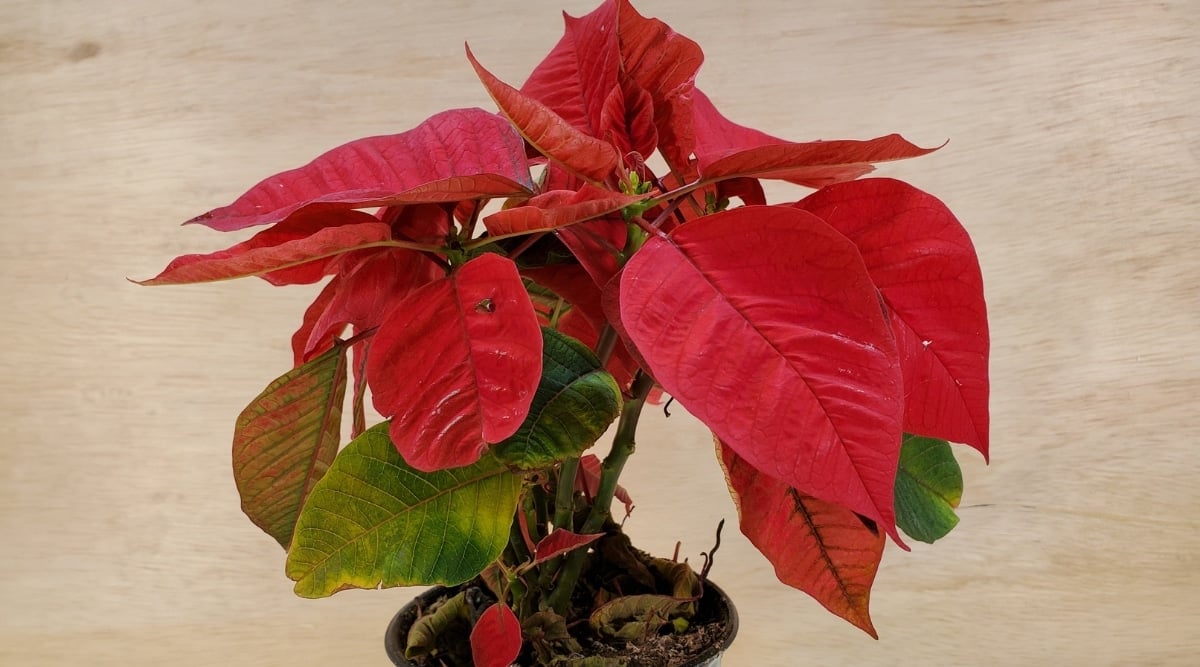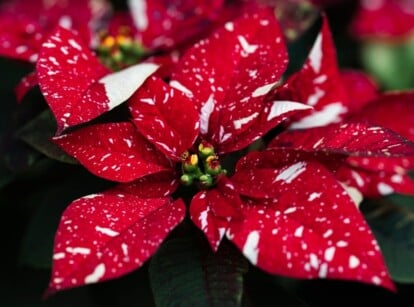11 Care Tips For Poinsettia Plants in Containers
Are you decorating with poinsettias this season? These festive plants have become a holiday essential, and we want to help you keep yours looking beautiful for as long as possible. In this article, gardening expert Danielle Sherwood outlines 11 care tips for poinsettias in containers!

Contents
A symbol of the holiday season around the world, poinsettias are a fun and easy way to step up your winter container plant decor. These beauties have long been associated with Christmas, due to their brilliant winter bloom.
The colored part of poinsettias is not a flower at all. These “blooms” are actually its specialized leaves, called bracts. The real flowers are called cyathia. These are the small light green or yellow buds found at the center of each bract, which open to tiny yellow blossoms.
Once only available in red, white, and pink, you now have a beautiful array of poinsettia colors and bract shapes to choose from! They are ideal to give as hostess gifts, and come in a variety of sizes, from diminutive minis to small trees!
Poinsettias are fairly low maintenance as container plants, but they are picky about a few things. With knowledge of their ideal conditions, you can ensure that your poinsettia looks good throughout the season. So, what do poinsettias need to keep looking their best?
Choose a Healthy Plant

Many poinsettias are displayed in less than optimal conditions. Though neglected store poinsettias can be salvaged, it’s preferable to purchase one with a great start that will give you a long life span. Inspect the poinsettia thoroughly before bringing it home.
Very sensitive to light and cold, poinsettias need a sheltered location away from drafty doorways or heat sources. Avoid poinsettias that are placed right near store entrances, as they might already be struggling to thrive.
Pick a poinsettia with cyathia in the bud stage, and healthy, fully colored bracts. Leaves should be robust, green, and go all the way down the stem. Skip any poinsettias that have yellowing leaves, are wilting, or turning brown.
Check the soil. It should be evenly moist, and not overly soggy or bone dry. You can verify that the plant has healthy roots by gently turning it upside down and sliding it out of the pot. Roots should be white and plentiful.
Protect Your Poinsettia on the Trip Home

Some of us are enticed by beautiful poinsettia displays, and end up buying one on a whim in the middle of our holiday shopping. However, poinsettias should not wait in a cold car while you finish checking off your list!
Extreme temperature fluctuations of heat and cold can cause poinsettias to wilt and lose their leaves. Exposure to weather below 50℉ can even kill the plant. After purchasing your poinsettia, bring it directly home.
True to their tropical nature, poinsettias can’t stand cold air. If you are in a chilly winter climate, cover your poinsettia with a bag or jacket when walking it back to your car.
Provide a Container With Drainage

Poinsettias can last the season in the pot they came in. In fact, repotting during winter can shock the plant and cause it to struggle. However, you must remove the decorative foil sleeve that covers the pot to allow the plant’s roots to breathe.
If you’d like to display your poinsettia in a more decorative container, choose one slightly larger than its nursery pot, and place the plastic pot inside. Any pot used for poinsettias should have adequate drainage, as they do not like to sit in wet soil.
If you do choose to repot, select a pot with holes on the bottom that’s similar in size to its original container. Fill it with all-purpose soil amended with a bit of perlite for drainage. Check your poinsettia carefully for signs of stress over the next week or so.
Provide Adequate Sunlight

Poinsettias do best when they are located near a bright, indirect light source. When kept in shady, dark areas, they are prone to leaf loss.
In front of a South-West or East facing window is ideal. Be careful that the leaves don’t touch cold window panes, which can shock and damage them.
Ensure that the location you select allows your poinsettia at least 6-8 hours of sunlight. If your home is very dark, you may want to provide artificial light via a grow lamp.
Water Deeply

Poinsettias prefer infrequent, deep watering to provide adequate hydration to its roots. Depending on your household’s conditions, it may need to be watered more or less often. There are a couple ways to ensure your poinsettia is getting the water it needs.
The best method is to do a knuckle test. Simply stick your finger into the soil down to your knuckle. If the soil is dry at that depth, the plant needs water.
Take the poinsettia in its nursery pot and place it in your sink. Let lukewarm water saturate the soil to reach the roots, and keep it in the sink until it’s no longer dripping from the bottom of the pot. When all excess water has drained out, place your poinsettia back in its decorative pot or chosen location.
Only water when the top few inches of soil are completely dry, avoiding overly wet soil and soggy roots. If you lift the pot and it feels very light, chances are, it’s ready for another watering session.
Keep Away From Cold and Heat

You already know that poinsettias are very sensitive to cold drafts, but did you know that placing them near heat sources can be damaging too? Poinsettias prefer a stable temperature between 65-75℉, and struggle if major fluctuations occur.
We all love poinsettias greeting us in an entryway, but it’s best to keep them in a sheltered location, away from bursts of cold air from a frequently opened door.
Likewise, keep your poinsettia away from heating vents and the fireplace. Too much cold or heat will shorten your plant’s lifespan.
Provide Adequate Humidity

Poinsettias flourish in a slightly humid environment. They love moist air with humidity between 55%-75%.
If you have dry air inside your home, you can help your poinsettia in a couple of ways. The easiest is to buy several and bunch them together. This provides a slightly humid microclimate that will help them maintain moisture.
You can also run a humidifier or a mister. When misting, make sure you don’t let excess water sit on the leaves. Whatever the method you choose, check the soil often in dry conditions to make sure your poinsettias have adequate moisture.
Don’t Fertilize

Sometimes, we can smother our plants with too much love! In the case of poinsettias, refrain from providing any fertilizer during the bloom period.
The bracts change color and provide the poinsettia’s signature look just before entering dormancy. They don’t need any extra nutrients to encourage new green growth during this period.
In fact, too much fertilizer can cause poinsettias to develop Bract-Edge Burn, which damages fragile roots and causes leaf edges to turn brown. Your poinsettia’s soil likely already contains slow-release fertilizer, providing all it needs for the winter months.
If you choose to keep your poinsettia alive year-round, you can add fertilizer after its rest period in the spring.
Address Wilting Foliage

The last thing you want is to bring your poinsettia home, only for it to droop and look sad! There are a few reasons this can happen.
The plant may have been already struggling when you bought it, and is now adjusting to the shock of its new location. Give it adequate water, sun, and humidity, and see if it rebounds. Remove any fallen or disfigured leaves from the pot right away to prevent spread of possible disease.
The number one cause of wilting is over or under-watering. Remember to let the top few inches of soil dry out completely before watering. When watering, ensure that the moisture gets all the way down to the roots and drains thoroughly before placing it back in its decorative container.
Droopy poinsettias can also be suffering from lack of light. Try placing it in a brighter spot or providing additional artificial lighting.
Control Pests

In the cold winter season, bugs are often the last thing on our minds. However, it’s possible that your poinsettia came to you with a hidden infestation. Poinsettias are prone to damage from white flies, fungus gnats, and spider mites.
When purchasing your plant, always inspect the undersides of leaves to check for pests. Avoid any leaves with white spots (unless they’re characteristic of the cultivar) or holes that indicate pest presence.
If you discover a pest problem when your poinsettia is already home, remove any badly damaged leaves. Use a soft cloth to gently remove any visible bugs and get rid of them.
Place a yellow sticky trap in the pot to capture and dispose of pests that are harder to see. Make sure that your soil doesn’t stay soggy, encouraging pests to proliferate.
Keep Your Poinsettia Alive All Year

A great majority of people discard their poinsettias after they lose their seasonal color, but did you know you can keep your poinsettia as a beautiful plant all year long? With some effort, poinsettias will grow bigger each year and provide pizazz to your holiday décor for years to come! This rewarding process saves you money and lets your plant live a long, healthy life.
After poinsettias lose their color, the bracts will wither and dry up as the plant enters dormancy. This is its annual rest period. In the spring, cut your poinsettia back to 5-6 inches, and fertilize once a month. Keep watering whenever the top soil is dry.
During the warm summer months, poinsettias can be kept outside (as long as nighttime temps stay above 55℉), and even planted in the ground! You’ll see lots of new green growth during this time. Repot if needed.
Poinsettias are photoperiodic, meaning they need bright days and long periods of total darkness to achieve their seasonal color. Beginning in September, provide complete darkness for your plant from 5 pm to 8 am by covering it with a cardboard box or placing it in a closet, continuing to give it bright light during the day. Just don’t leave it in the dark for too long!
By mid-November, the bracts of your poinsettia will begin to develop their signature color. Choose your plant’s spot for the season, leave it there, and enjoy! Each year, your poinsettia has the potential to grow bigger and more impressive.
Final Thoughts
With a little care, poinsettias can provide holiday cheer to your home for 6-8 weeks. Keep it as a pretty green plant all year long, and you’ll be rewarded with lovely color each season. Whether just for the holidays or beyond, this iconic Christmas plant is a fun and festive reminder to enjoy the changing seasons!









